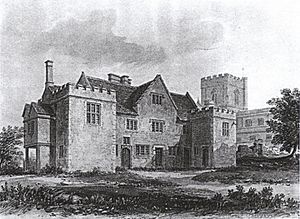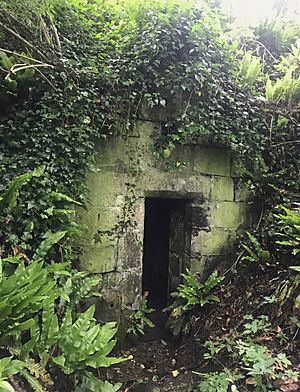Edington Priory facts for kids
Edington Priory is an old church in Wiltshire, England. It was started in 1351 by William Edington. He was a bishop and lived in the village of Edington. This village is about 6 kilometers (3.75 miles) east of Westbury. The church was finished in 1361. Today, it is still used as a local church called Saint Mary, Saint Katharine and All Saints.
Contents
History of the Priory
How it Started
Edington was mentioned in the Domesday Book in 1086. At that time, it belonged to Romsey Abbey. There was likely a church here even before 1086. The first official record of a church is from 1241. During repairs in the 1800s, parts of an old Norman church were found.
William Edington's Role
William Edington (who died in 1366) came from a family in Edington. He became an important person in England, serving as the Lord High Treasurer and a bishop of Winchester. In 1351, he set up a special fund, called a chantry, at Edington. This was so prayers could be said for him and his family. The church was then given to this chantry. William Edington gave more money and land to the church in the years that followed.
The Monastery Years
In 1358, the chantry became a home for a group of monks called the Brothers of Penitence (also known as Bonhommes). This new monastery was based on another one called Ashridge Priory. William Edington and others added many more properties to the monastery's wealth until he died in 1366.
The first leader of the monastery was John de Aylesbury. He came from Ashridge. When he died in 1382, there were eighteen monks living there.
In 1450, during Jack Cade's rebellion, William Ayscough, the Bishop of Salisbury, had to run away. He tried to hide in the church at Edington. But on June 29, he was found during a church service. He was taken outside and killed in the fields near the church.
Not much is known about the monastery's daily life after this. In 1539, during the time when many monasteries were closed down (called the Dissolution of the monasteries), Edington Priory was given up. In 1541, most of its lands were taken by Sir Thomas Seymour.
What's Left of the Monastery
The area where the monastery once stood is north and northeast of the church. It is now a protected historical site. Besides the church, five other old structures are still standing. All of them, except the fishpond, are very important historical buildings (Grade I listed).
The Priory House
Right next to the north side of the church is an old house. It was built in the late Middle Ages and might include parts of the original monastery buildings. It was rebuilt around 1600 and changed a bit later on.
Old Monastery Walls
North and east of the church, there are two large gardens. They are surrounded by tall walls, about 3-4 meters high. These walls are probably from the monastery and were changed in the early 1600s. One wall has round pillars that might be what's left of a cloister (a covered walkway).
Cottage on a Monastic Wall
Northeast of the church, on the road to Steeple Ashton, there's a cottage called The Monastery Garden. It might be from the 1500s. It was built into a long wall that could have been part of the monastery.
The Fishpond
North of the church, there is a large, rectangular pond. This pond was likely used by the monks to keep fish for food. Other ponds nearby have been filled in over time.
Ladywell Conduit Head
About 400 meters southwest of the church, there's a small building from the 1300s. It stands over a spring called Ladywell. Inside, there are stone troughs for water. A conduit (a pipe or channel) carried water from this spring all the way to the monastery.
The Parish Church Today
The church is still standing and is a great example of how church building styles changed in England. It shows a mix of the "decorated" and "perpendicular" styles of English Gothic architecture. One writer, Pevsner, said it looks like a "fortified mansion" because of its varied roofline and battlements.
The entire church from the 1300s is still here. Its inside was improved in the 1600s. Later, Charles Edward Ponting restored it between 1888 and 1891. It was officially listed as a Grade I building in 1968.
The church has beautiful old stained glass windows. It also holds the tombs of several important local people. Some tombs were moved here from another church in Imber in the 1950s. This happened after the village of Imber was emptied in 1943.
In 2014, a new organ made by Harrison & Harrison was put into the church.
Every August since 1956, a special music event called the Edington Festival of Music within the Liturgy is held here.
Images for kids










